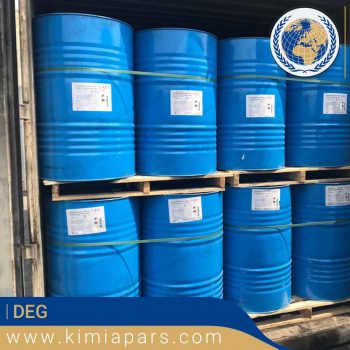Diethylene Glycol 99.8%
- Description
- Analysis of DEG
- Download of Analysis
Description
Di Ethylene Glycol | DEG
Chemical Formula of Di Ethylene Glycol: C4H10O3
Other names: diethylene glycol | ethylene diglycol | diglycol
Appearance: Colorless Liquid
Usages: DEG is used in the manufacturing of saturated and unsaturated polyurethanes, polyester resins, and plasticizers. Diethylene Glycol is also used in organic synthesis as a building block. DEG is a solvent for nitrocellulose, resins, dyes, oils, and other organic compounds.
Packaging: 220 kg new steel drum
Price: Negotiable, depending on the amount of the order
Payment terms: T/T 100% cash in advance
Min order: 1*20 ft. FCL
Delivery time: Within 5-10 days after we receive the payment
Origin: Iran
Di Ethylene Glycol (DEG) is a colorless, odorless, and nearly tasteless organic chemicals compound with the chemical formula HOCH2CH2OH. It is a viscous liquid that is soluble in water, alcohol, and other solvents. DEG is produced by the hydration of ethylene oxide, which is derived from petroleum or natural gas.
DEG has a wide range of industrial uses, making it a valuable component in many different industries. One of the primary uses of DEG is as a raw material in the production of polyester resins, which are used in a variety of applications, including the manufacture of clothing, upholstery, and industrial fibers. DEG is also used as a component in the production of other types of polymers, such as polyethylene terephthalate (PET), which is used to make plastic bottles, containers, and other products.
In the automotive industry, DEG is used as a component in engine coolants and antifreeze. The chemical is added to these products to lower the freezing point and increase the boiling point, which helps to protect the engine from damage caused by extreme temperatures. In addition, DEG is used as a component in hydraulic fluids, brake fluids, and other types of automotive lubricants.
The cosmetic and personal care industry also makes use of DEG as a component in a variety of products, including skin creams, lotions, and other skin care products. DEG is added to these products to help improve their texture and to help prevent the growth of bacteria and other microorganisms.
DEG is also used as a solvent in a variety of industrial applications. For example, it is used as a solvent in the production of paints, inks, and other coatings, where it helps to improve the flow and leveling of the products. In addition, DEG is used as a solvent in the pharmaceutical industry, where it is used to dissolve active ingredients in drugs and other pharmaceutical products.
In the agricultural industry, DEG is used as a pesticide and herbicide. The chemical is added to these products to help control pests and weeds, and to improve crop yields. However, the use of DEG in agriculture is controversial, as the chemical can be harmful to the environment and to human health if not used properly.
Aside from its industrial uses, DEG is also used in a variety of household products, including cleaning agents and disinfectants. The chemical is added to these products to help improve their cleaning ability and to help prevent the growth of bacteria and other microorganisms.
Despite its many benefits, DEG can be dangerous if not handled properly. The chemical is toxic if ingested and can cause serious harm if inhaled. In addition, DEG can cause skin irritation and other types of health problems if it comes into contact with the skin. Therefore, it is important to handle DEG with care and to follow proper safety procedures when working with the chemical.
In conclusion, DEG is a versatile chemical compound with a wide range of industrial uses. From its use as a raw material in the production of polyester resins and other polymers, to its use as a solvent and pesticide, DEG plays a crucial role in many different industries. However, it is important to handle the chemical with care and to follow proper safety procedures to avoid any harm. The many benefits of DEG make it an essential component in many industrial processes, and its versatility and cost-effectiveness make it a valuable solution for a range of applications.
DEG Analysis |
| Content | Test Result |
|---|---|
| Purity | Min 99.8% wt% |
| MEG | Max 0.05% WT% |
| TEG | Max 0.05% WT% |
| Water | Max 0.05% WT% |
| Acidity | Max 50 mg/kg |
| ASH | Max 50 mg/kg |
| SP.GR.@20/20°C | 1.1175-1.1195 |

